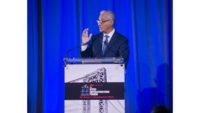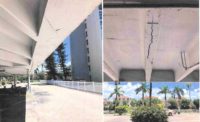Structural Engineering
Oklahoma City Council OKs Plan for North America's Tallest Tower
A performance-based structural design will be used on the project

The base (left) and slender, record-breaking Legends Tower as envisioned for the Boardwalk at Bricktown multiuse development in Oklahoma City.
Renderings courtesy of AO
The Oklahoma City Council approved a zoning change June 4 allowing a developer to build what is planned to be a 1,907-ft tower—and North America's tallest structure—in a mixed-use development.
The rezoning, which passed by am 8-to-1 vote, removes the height restriction originally placed on the site. Further approvals from the council will be needed as the plan moves ahead.
The project as currently envisioned consists of a base with three mid-rise towers and a fourth, the Legends Tower, that if built would set a height record for the U.S. and North America.
Mark Zitzow, a principal of civil engineer Johnson & Associates, said that in the three years since the project was first proposed to the council "the vision has changed and the project has become much more exciting."
If the plan by developer Matteson Capital goes forward, work on the slender tower would be part of a second phase that would begin in about two years, Rob Budetti, managing partner of AO, the architectural consultant to the project, told the council.
The base and smaller towers would be built first, he said.
Officials of Matteson Capital, who have been working with construction consultant Hensel Phelps, could not immediately be reached for comment for more details of their business plans.
Structural System Details
Structural consultant Thornton Tomasetti has developed concepts for the planned Legends Tower. It would have 134 floors and would contain about 2.5 million sq ft of space for residences topped by a hotel, according to Thornton Tomasetti.
In the current design, the height to the roof is 1,707 ft. That means an aspect ratio of about 16:1, which is considered slender, says Ola Johansson, Thornton Tomasetti’s senior principal on the project. The structural system has yet to be set but Thornton Tomasetti is using a sophisticated performance-based structural design approach (PBSD), which typically exceeds building code requirements. PBSD provides a higher level of performance with a higher predictability, Johansson says.
Thornton Tomasetti is also trying to minimize embodied carbon in the structure by balancing “brute-force engineering” for stiffness and "a more-sophisticated approach using outriggers and dampers,” Johansson says.

The tower structure and foundation will also be designed to withstand wind loads—including tornadoes—and seismic loads expected to occur at the site.
Wind and tornado forces will be established via wind tunnel testing, considering the local wind climate and the geometry and height of the tower. Similarly, seismic design forces will be established via site-specific testing and studies. In part because of the slender aspect ratio, the conceptual design calls for a high-strength reinforced concrete primary structure with a central core, with 3 ft or 4 ft thick walls, connected to perimeter columns by structural steel outrigger braces at three or four tower elevations, says Johansson.
Because outriggers add stiffness and strength to the core, the system has “provided excellent structural performance for other towers of similar or greater height,” says Johansson. Thornton Tomasetti also has engineered the 2,073-ft-tall Shanghai Tower, the 1,670-ft-tall Taipei 101 and the 1,483-ft-tall Petronas Towers, among its stock of supertall buildings.
It is likely there also will be a wind damping system for serviceability and creature comfort.
There are no column lines envisioned between the core and the perimeter. Floor slabs spanning from the core to perimeter columns may be post-tensioned concrete or composite—metal decking with a concrete topping. “We are looking into a composite system as well as concrete systems,” says Johansson.
According to the preliminary design, the reinforced concrete foundation mat is about 20-ft thick and bears on a grid of drilled concrete piers extending about 60 ft below grade to bedrock. “Soil conditions are favorable,” says Johansson.






